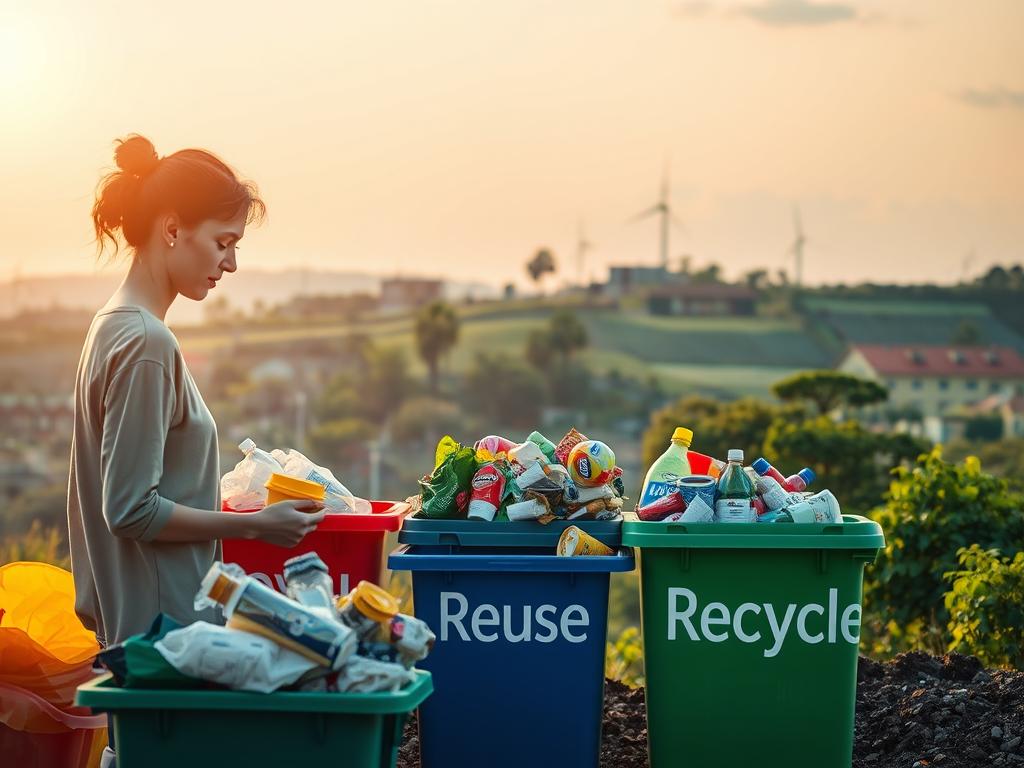The reduce reuse recycle concept is vital for sustainable waste management. Each Australian produces over 2000 kg of rubbish yearly. This staggering figure shows the urgent need for responsible waste practices.
The waste management hierarchy focuses on three key strategies. These are reduce, reuse, and recycle. This approach aims to lessen environmental impact by tackling waste at its source.
Sustainable waste management is crucial for our planet’s health. It helps conserve resources and protects our environment. By understanding these principles, we can make better choices.
We can reduce our environmental footprint through informed decisions. This includes how we consume, dispose of waste, and use resources. Small, intentional choices in our daily lives can make a big difference.
These practices offer a complete approach to resource management. They help conserve energy and protect natural habitats. By embracing this concept, we contribute to a more sustainable future.
What is the Concept of Reduce Reuse Recycle?
The three Rs – Reduce, Reuse, Recycle – form a sustainable waste management approach. This strategy aims to minimise waste, conserve resources, and reduce our ecological footprint.
The Origins of the Three Rs
The three Rs emerged from environmental concerns in the late 20th century. Global waste production had increased dramatically, prompting a search for innovative solutions.
The concept was first introduced in the 1970s environmental movement. It developed as a response to unsustainable consumption patterns.
- First introduced in the 1970s environmental movement
- Developed as a response to unsustainable consumption patterns
- Aimed at creating a more sustainable waste management approach
Environmental Impact and Importance
Recycling has a profound environmental impact. By using the three Rs, we can significantly reduce waste and conserve vital natural resources.
*”Every piece of waste we prevent is a step towards a healthier planet”*
Key environmental benefits include:
- Reducing landfill waste
- Conserving energy
- Minimising pollution
- Protecting natural habitats
Global Recycling Standards
Global recycling standards have been created for consistent waste management practices. Countries have developed unique approaches to the three Rs, with varying success rates.
Key statistics highlight the importance of these standards:
- Approximately 30% of waste in the United States is recyclable
- Only 35% of recyclable materials are actually recycled
- An estimated 75% of the American waste stream is potentially recyclable
The quest for effective waste management continues. Efforts to improve recycling infrastructure and promote sustainable consumption are ongoing.
The First R: Reducing Waste at the Source
Reducing waste is crucial for protecting our environment. It involves cutting down on consumption from the start. This approach prevents unnecessary waste and lessens our impact on the planet.
Simple waste reduction methods can make a big difference. Choosing products with less packaging is a great start. Using reusable items and buying only what you need also helps.
Planning purchases carefully is another effective strategy. These small changes can lead to significant waste reduction over time.
- Choosing products with minimal packaging
- Investing in reusable alternatives
- Purchasing only essential items
- Planning purchases carefully
Money can be a strong motivator for reducing waste. Using a metal water bottle can save you over £200 a year. Some shops offer discounts for bringing your own bags or cups.
These incentives make sustainable habits more appealing. They show how being eco-friendly can benefit your wallet too.
| Waste Reduction Method | Potential Annual Impact |
|---|---|
| Reusable Water Bottle | £200 Savings |
| Canvas Tote Bags | Reduced Plastic Waste |
| Minimal Packaging Choices | Significant Waste Reduction |
Global waste is a growing concern. The World Bank predicts a 70% increase by 2050 if we don’t change. Proactive waste reduction strategies can help slow this alarming trend.
Taking action now is vital for our planet’s future. Every small step counts in the fight against waste.
Every individual action towards reducing waste contributes to global environmental preservation.
The Second R: Creative Ways to Reuse Items
Reusing items is a powerful strategy to reduce waste. It turns potential rubbish into valuable resources. By reusing creatively, we can lessen our impact on the environment.
Creative reuse offers innovative solutions for everyday objects. It goes beyond simple recycling, opening up exciting opportunities.
Reusing allows us to reimagine discarded materials through upcycling. This process can dramatically reduce household waste. Strategic repurposing methods can make a big difference.
Household Items Repurposing
Everyday items often have hidden potential for reuse. Here are some creative transformations:
- Glass jars become storage containers or decorative planters
- Old clothing can be converted into cleaning rags
- Wooden pallets transform into furniture or garden structures
Upcycling Techniques
Upcycling turns waste materials into higher-value products. Here are some inspiring approaches:
- Converting plastic bottles into vertical garden systems
- Transforming worn textiles into quilts or accessories
- Repurposing electronics into artistic installations
Community-Based Reuse Programmes
Local community reuse programmes are vital for sustainable waste management. These initiatives connect people and reduce waste. They also create social value in the community.
| Programme Type | Benefits | Community Impact |
|---|---|---|
| Swap Events | Reduce individual consumption | Promotes circular economy |
| Repair Cafés | Extend product lifecycles | Builds technical skills |
| Second-Hand Markets | Lower waste generation | Supports local economies |
Creative reuse ideas and community programmes can transform waste management. They turn challenges into opportunities for innovation and environmental care.
The Third R: Recycling Process and Benefits
Recycling turns waste into new products, promoting sustainable waste management. This process involves crucial stages that help save resources and protect the environment.
Knowing recyclable materials is key for effective recycling. Each material needs specific processing methods:
- Paper can be recycled up to seven times
- Aluminium can be repeatedly recycled without quality loss
- Glass can be endlessly recycled without degradation
- Plastic requires careful sorting by type
Recycling offers benefits beyond waste reduction. Here are some impressive facts:
| Material | Recycling Impact |
|---|---|
| Paper | Saves 17 mature trees per ton recycled |
| Aluminium | 95% energy savings in production |
| Plastic | Reduces greenhouse gas emissions |
Recycling supports a circular economy by reducing waste and saving energy. It minimises our impact on the planet’s resources.
Residents can help by sorting materials correctly. Understanding local recycling rules and joining community programmes is also important.
Recycling isn’t just about waste management—it’s about creating a sustainable future for our planet.
Conclusion
Reduce, reuse, recycle principles are vital in our modern world. Small, meaningful actions can create significant environmental impact. Every individual can contribute to resource conservation through simple steps.
The three Rs show how sustainable lifestyle choices can transform waste management. Recycling aluminium cans saves 95% of energy compared to raw material production. Paper recycling reduces energy consumption by 60%.
Environmental stewardship requires collective commitment. The reduce, reuse, recycle framework helps minimise waste and conserve resources. It also decreases greenhouse gas emissions, contributing to a more sustainable future.
Sustainable living is a continuous journey of conscious choices. It involves innovative approaches to resource management. We can drive meaningful change through our daily practices and commitment to environmental protection.


